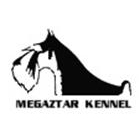GENERAL INFORMATION
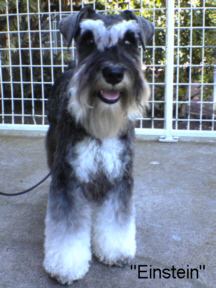 The spirited, lively and affectionate miniature schnauzer is a dog of clean habits and neat size, the perky dog makes a delightful little companion for an apartment dweller or someone with a small house and yard.
The spirited, lively and affectionate miniature schnauzer is a dog of clean habits and neat size, the perky dog makes a delightful little companion for an apartment dweller or someone with a small house and yard.
‘The Miniature Schnauzers give people an impression of a petite old fellow in popular seventies bell-bottom pants. And what lies behind the profuse whiskers, thick eyebrows and hairy legs is a dog that charms countless hearts…‘
HISTORY
‘A bearded mouth’ is the meaning of the word Schnauzbart, the German name for Schnauzer. Originated from Germany, the Schnauzers were once employed as an expert ratcatcher, and also for cattle and sheep herding. Today in some countries, Schnauzers have even been trained as police dogs and pets for the handicapped.
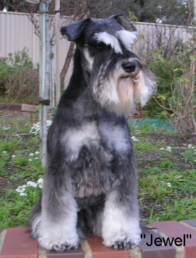 The Miniature Schnauzer is the smallest of the three Schnauzer breeds (Standards, Giants & Miniatures) The Standard and Giant Schnauzers are the descendants of the Middle Ages’ Beaver Dogs. The Miniature Schnauzer was later developed in the 1890s by crossing small specimens of the Standard Schnauzers with the Affenpinscher. The Schnauzers caught the attention of the public only after WWI, and seven years after the war, the Schnauzer Club of America was formed. At that time, the Miniature Schnauzers and the Standard ones were classified and shown together. However, the distinct interest in the two Schnauzer types soon became apparent that in 1933, the American Miniature Schnauzer Club was formed to take care of the specific needs and interest of the Miniature Schnauzers, thus separating them from the Standard type.
The Miniature Schnauzer is the smallest of the three Schnauzer breeds (Standards, Giants & Miniatures) The Standard and Giant Schnauzers are the descendants of the Middle Ages’ Beaver Dogs. The Miniature Schnauzer was later developed in the 1890s by crossing small specimens of the Standard Schnauzers with the Affenpinscher. The Schnauzers caught the attention of the public only after WWI, and seven years after the war, the Schnauzer Club of America was formed. At that time, the Miniature Schnauzers and the Standard ones were classified and shown together. However, the distinct interest in the two Schnauzer types soon became apparent that in 1933, the American Miniature Schnauzer Club was formed to take care of the specific needs and interest of the Miniature Schnauzers, thus separating them from the Standard type.
They are only classified as terriers in the U.S.; most countries classify all Schnauzers as utility or working dogs.
DESCRIPTION
BUILT TO LAST
 A strong, robust, angular, square-looking dog, the Miniature Schnauzer has a harsh, wiry double coat that comes in salt/pepper color, black/silver color and solid black color. The thick, prominent eyebrows and long mustache are often trimmed to accentuate the dog’s square-cut shape and the tail is usually docked.
A strong, robust, angular, square-looking dog, the Miniature Schnauzer has a harsh, wiry double coat that comes in salt/pepper color, black/silver color and solid black color. The thick, prominent eyebrows and long mustache are often trimmed to accentuate the dog’s square-cut shape and the tail is usually docked.
When you carry a mini schnauzer puppy, you will immediately realise that it is a sturdy, muscular and slightly heavy puppy. Its disposition is that of a happy dog, spirited and intelligent. Adaptable to different environments, the Miniature Schnauzer is most suitable with young active families. It is good with children too, especially those with matching level of energy.
TEMPERAMENT
A SMALL DOG WITH A BIG PERSONALITY
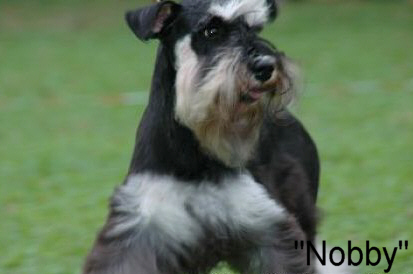 The mini schnauzer is a small, robust dog. Though it is the smallest of the three Schnauzer types, it is in no way inferior to its two cousins. It has a bark that can mislead strangers into believing that a huge dog is on guard. Its terrier instincts, alertness, boldness, keen sense of hearing and smell, which made him a good ratter in the past have made him a steadfast protector today.
The mini schnauzer is a small, robust dog. Though it is the smallest of the three Schnauzer types, it is in no way inferior to its two cousins. It has a bark that can mislead strangers into believing that a huge dog is on guard. Its terrier instincts, alertness, boldness, keen sense of hearing and smell, which made him a good ratter in the past have made him a steadfast protector today.
As a pet, the MS is fast becoming a popular choice. It is lively and friendly, playful yet devoted. Unlike some small breeds, MS is not toyish. It is hardy and has a high level of energy. They thrive on regular exercise and involvement in family activities. The MS’s endearing nature also includes a good temperament and an attitude that found favour with most pet lovers.
GROOMING
A UNIQUE COAT
 A Miniature Schnauzer has a hard wiry outer coat and a close undercoat. Its coat is non-shedding and this makes it perfect for people who suffer from allergies to dog hairs. The MS’s coat needs special trimming to maintain the Schnauzer look. Groomers usually clip the head, neck and body coat short, close to the body, and only trim the hairs on the legs and under chest slightly to give them a fluffy but not messy furnishing. The eyebrows are scissored in an inverted V shape and the whiskers are kept long and combed forward. This bearded muzzle well furnished with soft hair is a distinct feature of the Miniature Schanzuer. The clipping of the schnauzers’ coat will result in the lost of the harsh wiry coat typical of them replaced by a softer gray or silver-colored undercoat.
A Miniature Schnauzer has a hard wiry outer coat and a close undercoat. Its coat is non-shedding and this makes it perfect for people who suffer from allergies to dog hairs. The MS’s coat needs special trimming to maintain the Schnauzer look. Groomers usually clip the head, neck and body coat short, close to the body, and only trim the hairs on the legs and under chest slightly to give them a fluffy but not messy furnishing. The eyebrows are scissored in an inverted V shape and the whiskers are kept long and combed forward. This bearded muzzle well furnished with soft hair is a distinct feature of the Miniature Schanzuer. The clipping of the schnauzers’ coat will result in the lost of the harsh wiry coat typical of them replaced by a softer gray or silver-colored undercoat.
For show dogs, they need to maintain that harsh coat and thus the alternative is to strip or pluck, instead of clippering. Whether clippering or stripping, it has to start when the dog is young so to get him used to it.
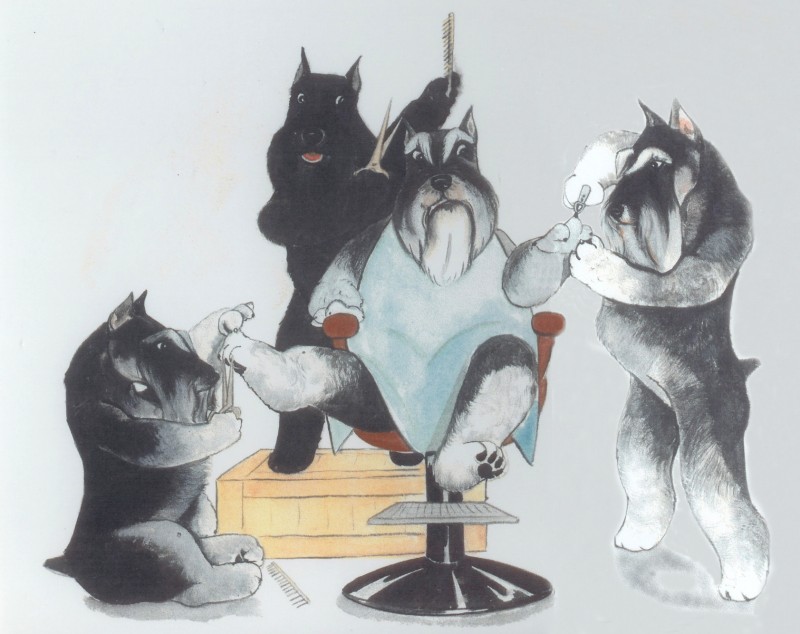 Regular maintenance is necessary for this breed. It should be brushed at least 3 times a week. This not only keeps the coat tidy and matt free, it stimulates the body’s natural oils. First brush along with the growth of the hair to untangle any matts. Then brush against the growth of hair to clean undercoat and massage the skin. Finally brush with the growth of hair again to keep it neat. The MS should be bathed and groomed every 6-8weeks.
Regular maintenance is necessary for this breed. It should be brushed at least 3 times a week. This not only keeps the coat tidy and matt free, it stimulates the body’s natural oils. First brush along with the growth of the hair to untangle any matts. Then brush against the growth of hair to clean undercoat and massage the skin. Finally brush with the growth of hair again to keep it neat. The MS should be bathed and groomed every 6-8weeks.
Besides coat care, the ears should be cleaned weekly and nails clipped regularly. The teeth should also be brushed regularly to prevent dental carries. Allowing the dog to chew on raw bones will help keep the teeth clean. Clean the whiskers after a meal especially if the dog feeds on canned or wet foods. Eye stains can be cleaned with damp cotton buds. Furs around their paw pads should be trimmed at least weekly with a pair of scissors to prevent them slipping on tiled flooring or polished floorboards. Furs around the anal area should also be trimmed weekly to maintain hygiene by preventing poo from sticking onto their furs around that area.
EXERCISE & TRAINING
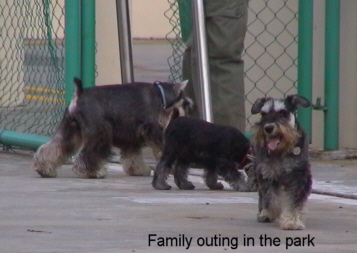 These energetic little dogs enjoy long, brisk, daily walks, and relish play sessions off the leash. The mini schnauzers are obedient and highly trainable, the MS makes it a pleasure for owners to engage in training sessions. It is recommended for puppies to attend ‘Puppy Kindergarten’ for socialization and training. Contact your local obedience club or school to organise training with them. It is a good place for the dog to learn, exercise and socialize at the same time.
These energetic little dogs enjoy long, brisk, daily walks, and relish play sessions off the leash. The mini schnauzers are obedient and highly trainable, the MS makes it a pleasure for owners to engage in training sessions. It is recommended for puppies to attend ‘Puppy Kindergarten’ for socialization and training. Contact your local obedience club or school to organise training with them. It is a good place for the dog to learn, exercise and socialize at the same time.
DIET
When the puppy is still young, it is advisable to feed him with dry food in small quantities at frequent intervals. Always feed the dog at the same time, same place, to cultivate good eating habits. Avoid feeding him with table scraps, and at places other than his usual dining area.
 At 6 months, your puppy can be fed twice a day and as he reaches on year old, one meal is usually sufficient. As the puppy matures, you may change his diet from puppy to adult food by slowly decreasing the puppy food and increasing the adult food. A good commercially prepared food, dry or canned are fine so long as they are nutritionally balanced and contain meat and grains, both required by the dog. Fresh water and fruits are essential to the dog’s well being and occasional treats can be used when teaching the dog some tricks. Over indulgence in treats is a no-no.
At 6 months, your puppy can be fed twice a day and as he reaches on year old, one meal is usually sufficient. As the puppy matures, you may change his diet from puppy to adult food by slowly decreasing the puppy food and increasing the adult food. A good commercially prepared food, dry or canned are fine so long as they are nutritionally balanced and contain meat and grains, both required by the dog. Fresh water and fruits are essential to the dog’s well being and occasional treats can be used when teaching the dog some tricks. Over indulgence in treats is a no-no.
If you choose to go with dry commercial dog food, it is important to take note of the ingredients in the packaging before giving it to your dog. Some poor quality commercial dog food contains preservatives such as BHA, BHT or Ethoxyquin which are known to cause cancer in dogs.
HEALTH PROBLEMS
Miniature Schnauzers are hardy and relatively free from diseases. They rarely have hip or knee problems. Over the years, breeders have been careful in selecting their breeding stock and screening them for eye, hip and heart problems. Some of the diseases that the miniature schnauzers are susceptible to are:
Congenital Juvenile Cataracts
This hereditary problem usually occurs at birth, and will progress to cause blindness. In dogs from the show line, this defect is rare. So it is important to choose you MS from a reputable breeder who constantly checks his breeding stock and have their eyes annually tested.
Schnauzer Comedo Syndrome
This is characterized by scaling on the skin and chronic blackheads along the back. Some cases of this can be related to allergy, metabolic disorders or simply lack of good care. To prevent this, pay attention to the cleanliness and hygiene, grooming and diet of the dog
Urinary Tract infections – Urolithiasis
This occurs at a higher rate in the Miniature Schnauzers than other breeds. The infected animal can be seen urinating frequently and my carry blood in the urine. If not treated, this can lead to bladder stones, and in severe cases, urinary blockage. Prescription diets, antibiotics or surgery are used to combat this disease. Dogs with a history of this should not be bred.
Von Willebrand’s Disease
This is a bleeding disorder that prolongs blood clotting and can cause complications during surgery. It is seen only in young puppies or debilitated animals. Though a large number of dogs who tested positive for this disease never experience problems, breeders are still careful and screen their breeding stock.
Hypothyroidism
Hypothyroidism is the number one inherited disease of dogs in general. It is caused by malfunction of the thyroid gland and affects the dog’s metabolism, causing depression, weight gain, lethargy, hair loss and an intolerance to cold. Supplementation of the thyroid decreases problems and most dogs live healthy lives.
BREED STANDARDS
General Appearance
The Miniature Schnauzer is a robust, active dog of terrier type, resembling his larger cousin, the Standard Schnauzer, in general appearance, and of an alert, active disposition. 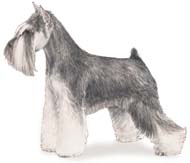 Faults – Type – Toyishness, ranginess or coarseness.
Faults – Type – Toyishness, ranginess or coarseness.
Size, Proportion, Substance
Size – From 12 to 14 inches. He is sturdily built, nearly square in proportion of body length to height with plenty of bone, and without any suggestion of toyishness. Disqualifications – Dogs or bitches under 12 inches or over 14 inches.
Head
Eyes – Small, dark brown and deep-set. They are oval in appearance and keen in expression. Faults – Eyes light and/or large and prominent in appearance.
Ears – When cropped, the ears are identical in shape and length, with pointed tips. They are in balance with the head and not exaggerated in length. They are set high on the skull and carried perpendicularly at the inner edges, with as little bell as possible along the outer edges. When uncropped, the ears are small and V-shaped, folding close to the skull.
Head strong and rectangular, its width diminishing slightly from ears to eyes, and again to the tip of the nose. The forehead is unwrinkled. The topskull is flat and fairly long. The foreface is parallel to the topskull, with a slight stop, and it is at least as long as the topskull. The muzzle is strong in proportion to the skull; it ends in a moderately blunt manner, with thick whiskers which accentuate the rectangular shape of the head. Faults – Head coarse and cheeky. The teeth meet in a scissors bite. That is, the upper front teeth overlap the lower front teeth in such a manner that the inner surface of the upper incisors barely touches the outer surface of the lower incisors when the mouth is closed. Faults – Bite – Undershot or overshot jaw. Level bite.
Neck, Topline, Body
Neck – strong and well arched, blending into the shoulders, and with the skin fitting tightly at the throat. Body short and deep, with the brisket extending at least to the elbows. Ribs are well sprung and deep, extending well back to a short loin. The underbody does not present a tucked up appearance at the flank. The backline is straight; it declines slightly from the withers to the base of the tail. The withers form the highest point of the body. The overall length from chest to buttocks appears to equal the height at the withers. Faults – Chest too broad or shallow in brisket. Hollow or roach back.
Tail set high and carried erect. It is docked only long enough to be clearly visible over the backline of the body when the dog is in proper length of coat. Fault – Tail set too low.
Forequarters
Forelegs are straight and parallel when viewed from all sides. They have strong pasterns and good bone. They are separated by a fairly deep brisket which precludes a pinched front. The elbows are close, and the ribs spread gradually from the first rib so as to allow space for the elbows to move close to the body. Fault – Loose elbows.
The sloping shoulders are muscled, yet flat and clean. They are well laid back, so that from the side the tips of the shoulder blades are in a nearly vertical line above the elbow. The tips of the blades are placed closely together. They slope forward and downward at an angulation which permits the maximum forward extension of the forelegs without binding or effort. Both the shoulder blades and upper arms are long, permitting depth of chest at the brisket.
Feet short and round (cat feet) with thick, black pads. The toes are arched and compact.
Hindquarters
The hindquarters have strong-muscled, slanting thighs. They are well bent at the stifles. There is sufficient angulation so that, in stance, the hocks extend beyond the tail. The hindquarters never appear overbuilt or higher than the shoulders. The rear pasterns are short and, in stance, perpendicular to the ground and, when viewed from the rear, are parallel to each other. Faults – Sickle hocks, cow hocks, open hocks or bowed hindquarters.
Coat
Double, with hard, wiry, outer coat and close undercoat. The head, neck, ears, chest, tail, and body coat must be plucked. When in show condition, the body coat should be of sufficient length to determine texture. Close covering on neck, ears and skull. Furnishings are fairly thick but not silky. Faults – Coat too soft or too smooth and slick in appearance.
Color
The recognized colors are salt and pepper, black and silver and solid black. All colors have uniform skin pigmentation, i.e. no white or pink skin patches shall appear anywhere on the dog.
Salt and Pepper – The typical salt and pepper color of the topcoat results from the combination of black and white banded hairs and solid black and white unbanded hairs, with the banded hairs predominating. Acceptable are all shades of salt and pepper, from light to dark mixtures with tan shadings permissible in the banded or unbanded hair of the topcoat. In salt and pepper dogs, the salt and pepper mixture fades out to light gray or silver white in the eyebrows, whiskers, cheeks, under throat, inside ears, across chest, under tail, leg furnishings, and inside hind legs. It may or may not also fade out on the underbody. However, if so, the lighter underbody hair is not to rise higher on the sides of the body than the front elbows.
Black and Silver – The black and silver generally follows the same pattern as the salt and pepper. The entire salt and pepper section must be black. The black color in the topcoat of the black and silver is a true rich color with black undercoat. The stripped portion is free from any fading or brown tinge and the underbody should be dark.
Black – Black is the only solid color allowed. Ideally, the black color in the topcoat is a true rich glossy solid color with the undercoat being less intense, a soft matting shade of black. This is natural and should not be penalized in any way. The stripped portion is free from any fading or brown tinge. The scissored and clippered areas have lighter shades of black. A small white spot on the chest is permitted, as is an occasional single white hair elsewhere on the body.
Disqualifications – Color solid white or white striping, patching, or spotting on the colored areas of the dog, except for the small white spot permitted on the chest of the black.
The body coat color in salt and pepper and black and silver dogs fades out to light gray or silver white under the throat and across the chest. Between them there exists a natural body coat color. Any irregular or connecting blaze or white mark in this section is considered a white patch on the body, which is also a disqualification.
Gait
The trot is the gait at which movement is judged. When approaching, the forelegs, with elbows close to the body, move straight forward, neither too close nor too far apart. Going away, the hind legs are straight and travel in the same planes as the forelegs.
Note – It is generally accepted that when a full trot is achieved, the rear legs continue to move in the same planes as the forelegs, but a very slight inward inclination will occur. It begins at the point of the shoulder in front and at the hip joint in the rear. Viewed from the front or rear, the legs are straight from these points to the pads. The degree of inward inclination is almost imperceptible in a Miniature Schnauzer that has correct movement. It does not justify moving close, toeing in, crossing, or moving out at the elbows.
Viewed from the side, the forelegs have good reach, while the hind legs have strong drive, with good pickup of hocks. The feet turn neither inward nor outward.
Faults – Single tracking, sidegaiting, paddling in front, or hackney action. Weak rear action.
Temperament
The typical Miniature Schnauzer is alert and spirited, yet obedient to command. He is friendly, intelligent and willing to please. He should never be overaggressive or timid.
Disqualifications
Dogs or bitches under 12 inches or over 14 inches.
Color solid white or white striping, patching, or spotting on the colored areas of the dog, except for the small white spot permitted on the chest of the black.
The body coat color in salt and pepper and black and silver dogs fades out to light gray or silver white under the throat and across the chest. Between them there exists a natural body coat color. Any irregular or connecting blaze or white mark in this section is considered a white patch on the body, which is also a disqualification.
* The above breed standard adapted from the American Kennel Club
